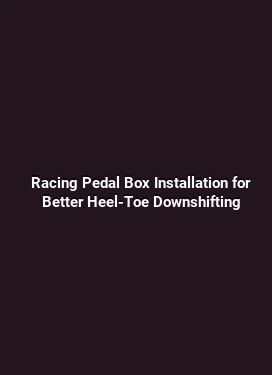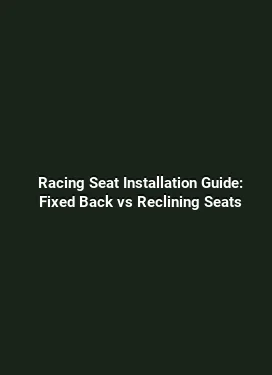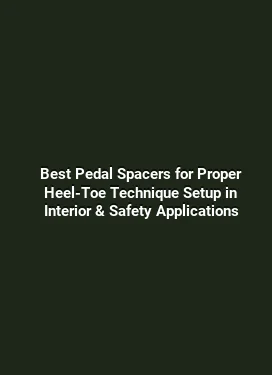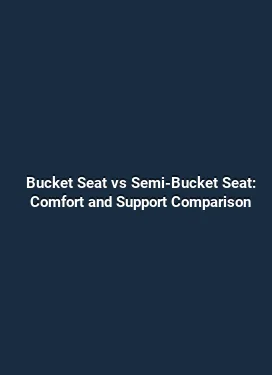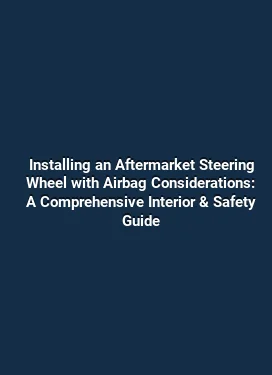Best Racing Harness Bar Installation Without Roll Cage
Installing a racing harness bar in a vehicle without a full roll cage requires careful planning, precise mounting, and an understanding of how the bar interacts with the cabin structure. This guide provides a detailed, step-by-step approach to selecting a harness bar, evaluating your car’s interior, choosing appropriate hardware, and performing a secure installation that preserves cabin integrity and occupant safety. The focus is on practical, real-world methods for enthusiasts who want enhanced restraint options without committing to a full roll cage.
Understanding Harness Bars and Safety Considerations

A harness bar is a horizontal crossbar that connects the A-pillar or other fixed points inside the cabin to provide a mounting point for multi-point racing harnesses. When installed correctly, harness bars distribute shoulder belt loads across stronger structural elements, reduce seat belt movement, and improve restraint performance during aggressive driving or track sessions. In the absence of a complete roll cage, it is essential to ensure that the mounting points do not compromise floorboards, firewall, or seat rails and that they do not interfere with airbag systems or vehicle sensors where applicable.
Proper safety considerations begin with an honest assessment of the car’s interior geometry and the intended use. Harness bars are most effective when paired with properly rated 4-point or 6-point harnesses that can accommodate the bar’s height and mounting angles. It is also important to understand how the bar interacts with occupant position, seat geometry, and headroom. A harness bar should not impede egress or obstruct the driver’s line of sight. Additionally, the bar should be designed to minimize sharp edges and should be finished to resist corrosion and wear from frequent use and cleaning products.
Material and Build Quality

The material choice for a harness bar typically includes steel or aluminum alloy. Steel bars generally offer higher strength and stiffness, which can be advantageous for load transfer. Aluminum bars provide a lighter weight option with sufficient rigidity for most applications. Regardless of material, look for welded or brazed joints that show consistent penetration, a smooth finish, and corrosion resistance. A well-made harness bar should have mounting points that align with factory or reinforced chassis points, minimizing stress concentrations and reducing the risk of cabin deformation under load.
Fitment Variations
Harness bars are available in a variety of configurations, including universal crossbars and vehicle-specific designs. Universal bars may require additional brackets or adapters to achieve correct alignment with the driver’s shoulder height and seat position. Vehicle-specific options often provide cleaner integration and easier installation, but they still demand careful measurement and compatibility verification with your seat rails and interior trim. When evaluating fitment, confirm the bar’s diameter, cross-section geometry, and the exact mounting point locations to avoid interference with seat tracks and passenger space.
Assessing Vehicle Suitability
Before purchasing a harness bar, inspect the interior structure for potential mounting anchors. The primary goal is to identify points with sufficient strength to support harness loads without compromising cabin safety. Vehicles with reinforced body lines, factory roll-cage-ready mounting points, or strong sills tend to be better candidates for harness bar installation without a roll cage. For cars with unibody construction, mounting efficiency often hinges on the door sills, A-pillars, B-pillars, or seat mounting brackets. It is crucial to avoid areas adjacent to airbags or side impact protection devices, as improper placement could affect deployment or occupant safety.
Consider the car’s seating arrangement as well. If the driver’s seat is deeply bolstered or mounted on sliders, the harness bar’s height and angle must accommodate safe belt routing without requiring excessive torso movement. The bar should allow the shoulder harnesses to sit across the strongest portion of the upper back while keeping the belts away from the neck and collarbone. In addition, check for any potential contact with the headliner, sun visors, or interior trim that could wear the belt or create noise during driving.
Interior Clearance and Accessibility
Clearance between the harness bar, seats, and steering wheel is critical. A bar placed too high can press against the helmet or interfere with shoulder belt routing, while a bar set too low may not provide optimal restraint geometry. Ensure that the installation does not hinder quick exits or create pinch points for arms and shoulders. Accessibility for belt adjustment and release should also be considered so that the driver can comfortably manage harness tension and quick-release mechanisms while wearing gloves.
Choosing the Right Harness Bar
Selecting the right harness bar involves evaluating mounting options, compatibility with harness types, and the bar’s ability to maintain proper belt angles under dynamic loads. The goal is to achieve a balance between strength, ease of installation, and minimal intrusion into daily driving or passenger space. Look for bars that expressly advertise compatibility with a range of seat types, including bucket seats, as this can influence how the belts align with the shoulder and hip anchors during cornering, braking, and acceleration.
Material choice, finish, and hardware quality are important because they impact durability and ease of maintenance. A good harness bar will feature corrosion-resistant fasteners, locking mechanisms to prevent loosening due to vibration, and clear instructions for torque specifications. Some bars come with compatible mounting brackets or spacers designed to align with the vehicle’s interior geometry, reducing the need for improvisation during installation.
Mounting Hardware and Brackets
Effective harness bar setups rely on robust brackets and hardware that distribute load across multiple mounting points. When possible, select bars that accompany multi-point bracket systems designed to anchor to reinforced structural members rather than thin trim. The use of locking hardware, such as Nyloc nuts or thread-locking compounds, helps maintain tension and prevent loosening under race conditions. Inspect all fasteners for finish wear before installation and replace any that show signs of fatigue, stripping, or corrosion.
Installation Steps Without a Roll Cage
Installing a harness bar without a roll cage requires a careful sequence to protect cabin integrity and ensure proper belt geometry. The steps below focus on a safe, repeatable process that can be performed with common workshop tools and with attention to detail. Always refer to the specific manufacturer’s installation instructions for torque values and per-point requirements, as these can vary between models and mounting configurations.
Step 1: Preparatory evaluation. Begin by removing interior trim around the A-pillar or wherever the harness bar will anchor. This helps visualize mounting points and ensures there is no interference with airbags, sensors, or wiring harnesses. Clean the surface to reveal any corrosion or damage that could affect the mounting location.
Step 2: Locate anchor points. Identify solid structural elements behind the panels, such as reinforced pillars or floor brackets. The goal is to attach the bar to points capable of withstanding the vertical and lateral loads imparted by the harness system. If factory reinforcement is unavailable, consider supplementary brackets designed for this purpose, ensuring they do not compromise occupant space or seat rail integrity.
Step 3: Mock-fit and align. With the harness bar positioned, check alignment with the driver’s shoulders, ensuring the belts will route cleanly across the upper torso without twisting. Use simple shims or temporary brackets to hold the bar in place while confirming clearance with helmeted head positions and seating configurations. Make necessary adjustments before final fastening.
Step 4: Secure mounting. Begin by tightening the primary anchors to the recommended torque, then progressively tighten secondary fasteners in a crisscross pattern to distribute load evenly. Recheck alignment after initial tensioning, and verify that the bar remains parallel to the ground and perpendicular to the belt lines. Avoid overtightening, which can induce structural deformation or transfer loads to weaker areas.
Step 5: Belt geometry verification. With the bar secured, fit the 4-point or 6-point harness and trace the shoulder belts across the bar. Confirm that they sit flat against the torso, without rolling or rubbing, and that the lap belts align across the hips without shifting during movement. Adjust strap angles if necessary using provided adjusters or mounting plates, staying within the manufacturer’s recommended geometry.
Mounting Points and Hidden Considerations
Choosing the right mounting points is critical for maintaining interior integrity and safety. If possible, select anchors that cooperate with existing frame members and that avoid interference with airbags or seat electronics. Some vehicles offer dedicated reinforcement for aftermarket safety equipment, which can simplify installation and reduce the risk of compromising cabin structure. It is essential to inspect for hidden wiring or sensors that could be damaged by bracket proximity or drilling during installation.
If drilling is required to create new mounting holes, take great care to protect interior surfaces and seal any penetrations against moisture and dust. Use corrosion-resistant fasteners and grommets to prevent metal-to-metal wear and reduce noise generated by metal contact within the cabin. It is also advisable to assess the potential impact on the vehicle’s resale value and warranty terms when modifying interior safety components.
Testing, Fine-Tuning, and Safety Checks
After installation, a thorough testing and inspection routine ensures the system behaves as expected under real-world conditions. Start with static checks: verify that all fasteners are locked, brackets are straight, and there are no visible gaps between mounting points and structural members. Then perform a controlled bench test by applying modest manual force to the bar to detect any unexpected movement or creaking sounds. Any abnormal feedback should prompt a recheck of torque values, alignment, and bracket integrity.
Dynamic testing is conducted by simulating driving loads using a seated position. Have the driver wear the intended harness during a controlled test drive with non-extreme maneuvers to observe belt path, tensioning behavior, and strap comfort. Check that the shoulder belts maintain proper angles during quick direction changes and that the belts do not bind on adjacent interior components. If any belt rub or misalignment occurs, readjust the mounting or replace wearing components as necessary.
Comfort, Ergonomics, and Access
Even the safest installation must remain ergonomic. A harness bar should not hinder the driver’s ability to reach controls, operate pedals, or check mirrors. The shoulder belt routing should avoid pushing directly into the collarbone, which can cause fatigue or discomfort on long sessions. Consider seat design, headrest compatibility, and helmet size when determining final belt angles. A well-considered setup reduces fatigue and promotes consistent lap times by keeping the driver focused on the road rather than fighting the seat belt.
As a practical tip, pair the bar with higher-back seats that provide appropriate shoulder support without constricting movement. If the race or track protocol requires a specific harness style, make sure the bar accommodates that configuration without forcing belts into uncomfortable angles. Regularly inspect belts for fraying or wear at anchor points, and replace any equipment showing signs of degradation.
Maintenance, Longevity, and Cleaning
Maintenance is an ongoing responsibility. Wipe down the bar and brackets with a mild cleaner that does not degrade metal finishes or rubber bushings. Periodically inspect the mounting hardware for looseness or corrosion and re-torque to the manufacturer’s specifications. When removing interior panels for routine maintenance or seasonal vehicle storage, document mounting positions and recheck alignment upon reassembly to ensure consistent belt routing.
Storage considerations matter as well. When a car is stored for extended periods, protect exposed fasteners from moisture and dust. Use protective caps or covers to seal any anchor points and prevent the ingress of debris that could hinder belt movement or cause corrosion. A proactive maintenance routine helps maintain proper safety performance and extends the life of the harness system and its supporting hardware.

